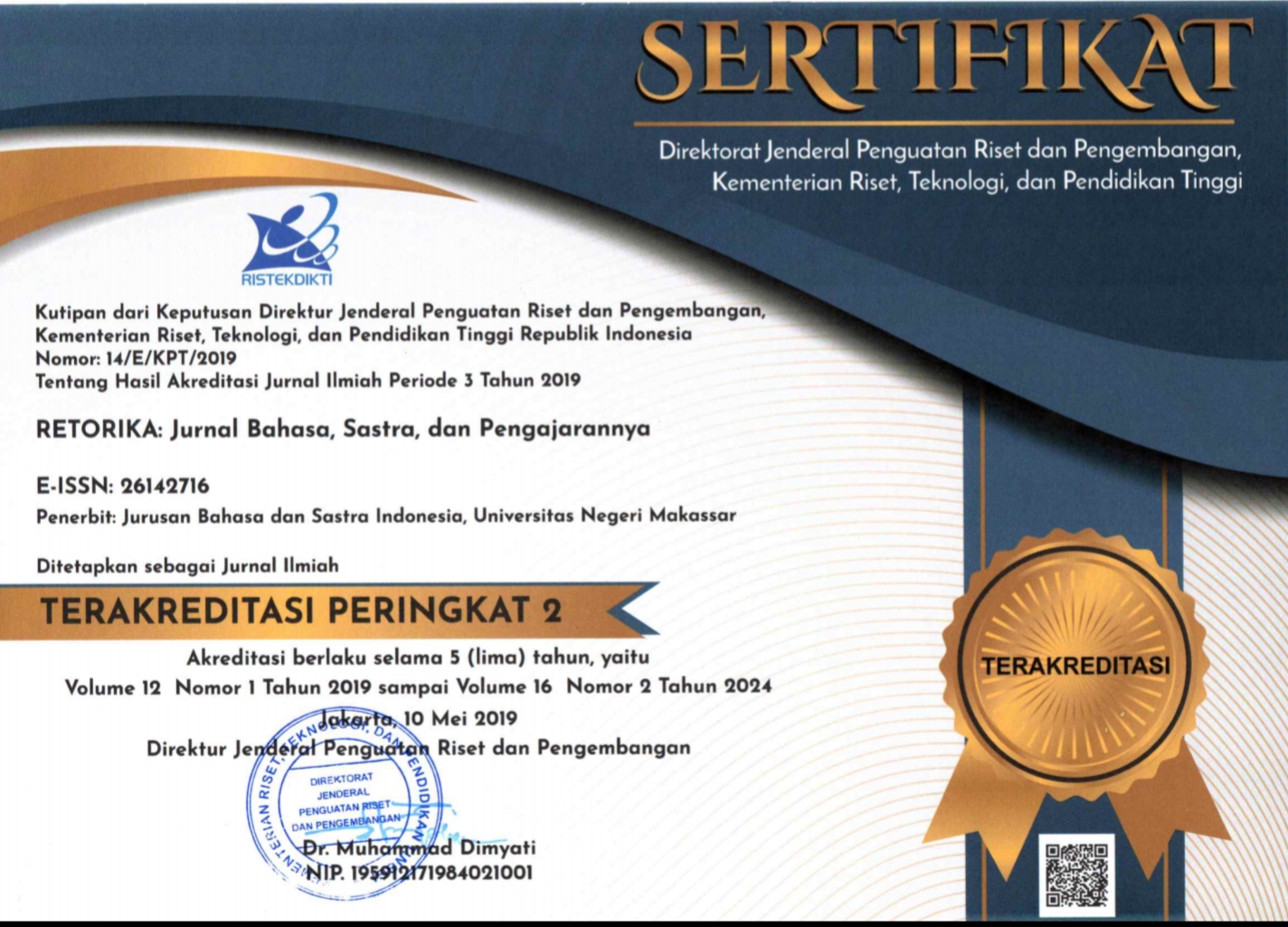VITALITY OF THE LAUJE LANGUAGE ENCLAVE IN THE FAMILY DOMAIN IN TOLITOLI REGENCY
(1) Badan Riset dan Inovasi Nasional (BRIN)
(2) Universitas Negeri Makassar
(3) Universitas Islam Negeri Datokarama Palu
(4) Badan Riset dan Inovasi Nasional (BRIN)
(5) Badan Riset dan Inovasi Nasional (BRIN)
(*) Corresponding Author
DOI: https://doi.org/10.26858/retorika.v17i1.58857
Abstract
Keywords
Full Text:
PDFReferences
A.D., Firman, Nfn Asri, & Nfn Sukmawati. (2020). Vitalitas Bahasa Tolaki di Kota Kendari (The Vitality of Tolaki Language in Kendari). Kandai 16(2):183. doi: 10.26499/jk.v16i2.2188.
Allouw, Novanda Yuliana. (2017). Mangantar: Menjembatani Proses Lamaran Menuju Pernikahan dalam Masyarakat Suku Lauje sebagai Pendekatan Pendampingan Prapernikahan Thesis, Magister Sosiologi Agama Program Pascasarjana FTEO-UKSW.
Amano, Tatsuya, Brody Sandel, Heidi Eager, Edouard Bulteau, Jens-Christian Svenning, Bo Dalsgaard, Carsten Rahbek, Richard G. Davies, & William J. Sutherland. (2014). Global Distribution & Drivers of Language Extinction Riski. Proceedings of the Royal Society B: Biological Sciences 281. doi: 10.1098/rspb.2014.1574.
Aritonang, Buha. (2016). Kriteria Vitalitas Bahasa Talondo. Ranah: Jurnal Kajian Bahasa 5(1):8–24.
Bramantyo. (2012). 139 Bahasa Daerah di Indonesia Terancam Puna : Okezone News. https://news.okezone.com/. Retrieved February 1, 2024 (https://news.okezone.com/read/2012/10/11/373/702667/139-bahasa-daerah-di-indonesia-terancam-punah).
Diani, Irma. (2016). Berbagai Faktor Penyebab Pergeseran Penggunaan Bahasa Serawai. Daun Lontar: Jurnal Budaya, Sastra, Dan Bahasa 3(03):14–35.
Efendi, Sentosa P. B., & Tamrin. (2016). Sastra Lisan Lauje (Analisis Struktur dan Nilai Budaya). Palu: Balai Bahasa Sulawesi Tengah.
Galloway, Nicola, & Heath Rose. (2018). Incorporating Global Englishes into the ELT Classroom. ELT Journal 72(1):3–14. doi: 10.1093/elt/ccx010.
Grimes, B. F. (2000). Ethnologue of The Word. Texas: Summer Institute of Linguistics, Inc.
Halliday, M. A. K. (2019). Linguistic Function and Literary Style: An Inquiry into the Language of William Golding’s ‘The Inheritors. Pp. 325–60 in Essays in Modern Stylistics. Routledge.
Hijra, Hijra. (2019). Reduplikasi Bahasa Lauje. Bahasa dan Sastra 5(2).
Inayatusshalihah. (2018). Kajian Vitalitas Bahasa Adang Di Nusa Tenggara Timur. Jakarta: Badan Pengembangan dan Pembinaan Bahasa.
Karmakar, Shubham. (2020). Ecolinguistics: The Integrity and Diversity of Language Systems. Jadavpur Journal of Languages and Linguistics 04(01):58–69.
KBBI. (2023). Arti Kata Didik-Kamus Besar Bahasa Indonesia (KBBI) Online. Retrieved February 1, 2024 (https://kbbi.web.id/didik).
Leonard, Wesley Y. (2023). Challenging ‘Extinction’ Through Modern Miami Language Practices. Pp. 126–65 in Global Language Justice. Columbia University Press.
Nursyamsi & Tamrin. (2019). Vitalitas Bahasa Pendau di Kabupaten Donggala, Sulawesi Tengah. Palu: Balai Bahasa Sulawesi Tengah.
Romaine, Suzanne. (2015). The Global Extinction of Languages and Its Consequences for Cultural Diversity. Pp. 31–46 in Cultural and Linguistic Minorities in the Russian Federation and the European Union. Springer, Cham.
Suharyo, Suharyo, & Nurhayati Nurhayati. (2020). Pemilihan Dan Pemertahanan Bahasa Jawa Pada Kaum Perempuan Pesisir Rembang. LITERA 19(3):397–413. doi: 10.21831/ltr.v19i3.28699.
Sumarsono. (2017). Sosiolinguistik. Yogyakarta: Pustaka Pelajar.
Susan Olajoke, Akinkurolere, & Akinfenwa Mercy Oluwapelumi. (2018). A Study on the Extinction of Indigenous Languages in Nigeria: Causes and Possible Solutions. Annals of Language and Literature 2(1):22–26. doi: 10.22259/2637-5869.0201003.
Tampanguma, Nikita, Thelma I. M. Wengkang, & Wimsje Palar. (2020). Pemertahanan Bahasa Tontemboan Pada Remaja Di Desa Poopo Kecamatan Passi Timur Kabupaten Bolaang Mongondow. Jurnal Bahtra 1(1). doi: 10.36412/jb.v1i1.2186.
Tamrin. (2018). Pola Pergeseran Bahasa: Kasus Pergeseran Bahasa Totoli Dalam Ranah Keluarga Berdasarkan Hubungan Peran dan Kategori Umur di Kabupaten Tolitoli. Multilingual 17(2):67–85.
Tamrin, T. (2014). Pemertahanan Bahasa Bugis dalam Ranah Keluarga di Negeri Rantau Sulawesi Tengah (The Buginese Language Preservation of Family Domain in Central Sulawesi Land).” SAWERIGADING 20(3):403–12.
Wurm, Stephen A. (1991). Language Death and Disappearance: Causes and Circumstances. Diogenes 39(153):1–18. doi: 10.1177/039219219103915302.
Zahari, M. (2011). Menjunjung Bahasa Persatuan. Jakarta: PT. Gria Media Prima.
Zubaidah, Neneng. (2014). 50 Bahasa Daerah Terancam Punah. SINDOnews Nasional. Retrieved February 1, 2024 (https://nasional.sindonews.com/berita/838060/15/50-bahasa-daerah-terancam-punah).
Article Metrics
Abstract view : 174 times | PDF view : 51 timesRefbacks
- There are currently no refbacks.
Copyright (c) 2024 Tamrin Tamrin, Abdul Haliq, Siti Fatinah, Muhammad Asri B.

This work is licensed under a Creative Commons Attribution-NonCommercial 4.0 International License.
Published by:
Department of Indonesian Language, Faculty of Languages and Literature, Universitas Negeri Makassar in cooperate with Asosiasi Dosen Bahasa dan Sastra Indonesia (ADOBSI) and Ikatan Program Studi Pendidikan Bahasa dan Sastra Indonesia (IKAPROBSI).
Address: Department of Indonesian Language Office, DG Building Second Floor, UNM Parangtambung, Daeng Tata Raya Street, Makassar, South Sulawesi, Indonesia
 Email: [email protected]
Email: [email protected]

RETORIKA: Jurnal Bahasa, Sastra,dan Pengajarannya is licensed under a Creative Commons Attribution-NonCommercial 4.0 International License.
















